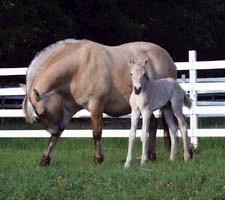breeds of horse
This page links to articles, by various authors, about different breeds of horse.
Named the American Quarter Horse because of its ability to outrun other breeds of horse over a quarter mile or less, with some horses having been recorded to run speeds up to 55 miles per hour (about 89 km/h). These days the American Quarter Horses can turn a hoof to most things that other breeds of horse can do, but is still well known for racing, ranch work, rodeo and the western performance and pleasure sports, including reining, barrel racing and trail riding. The American Quarter Horse is also successfully shown in English disciplines, driving, and showing - I knew of one who was an excellent cross country horse, but as cool as a cucumber in the Western ring.
American Quarter Horse colors: a discussion of quarter horse colors - real and registerable
The Arabian horse is an ancient breed of horse originating in the Arabian Peninsula. Archaeological evidence of horses similar to modern Arabians dates to over 4,500 years ago. It is thought that the Caspian horse, which is like a smaller version of Arab, may be its progenitor. Today Arabian bloodlines are found in almost all of the modern breeds of riding horse, having been used to add refinement but toughness. They were instrumental in the development of Thoroughbred horses.
Knabstrup horse The Knabstrup or Knabstrupper is a European breed of horse with the same coat patterns as the Appaloosa, ranging from solid to leopard spot, which is an especially favoured pattern. Patterns include blanket, snowflake, snowcap and “few spot”. Knabstruppers are strong hardy animals, but kind and easily trained.
It is thought that this breed of horse which has one of the oldest breed registries in Europe, descended from the prehistoric spotted horses of Iberia. The founder mare was a chestnut blanketed mare brought to Denmark in 1812. She was purchased by Major Villars Lunn who owned an estate called “Knabstrupgaard” in Nordsealand, Denmark. He bred the mare to a Fredricksborg stallion and produced an appaloosa patterned colt. The two spotted horses were bred to many good quality horses, establishing the Knabstrupper horse breed.
Paso Fino The "Paso Fino" may refer to the Pure Puerto Rican Paso Fino (PPR), or the Colombian Paso Fino or Colombian Criollo Horse (CCC). The Paso Fino is a light horse breed originally developed from imported Spanish horses, but the two groups developed independently of one another in the two countries. Paso Fino are naturally gaited horses with a smooth, four beat, lateral ambling gait. They are are particularly popular for trail riding.
The Thoroughbred was developed during the 17th and 18th centuries in England. Native mares, probably many of which were the now extinct Galloway horse breed, were crossed with imported stallions of Arabian, Barb, and Turkoman breeding. All modern Thoroughbreds can be traced back to three stallions imported into England in the late 17th and early 18th centuries, those being the Byerley Turk (1680s), the Darley Arabian (1704), and the Godolphin Arabian (1729). Unfortunately it seems likely that the high degree of inbreeding during the development of this breed has taken some toll, in the form of a high frequency of health problems and physiological defects.
Warmbloods are distinguished from heavy draft horses (often referred to as "cold bloods") and light "hot blooded" saddle horses such as the Thoroughbred and Arab. They are not direct first generation crosses of the two types, but rather descended from heavier agricultural horses that have been refined by inter-crossing with hot-bloodied horses so that there are now populations of a specific warmblood type.
A little about ancient breeds of horse.
|
|











